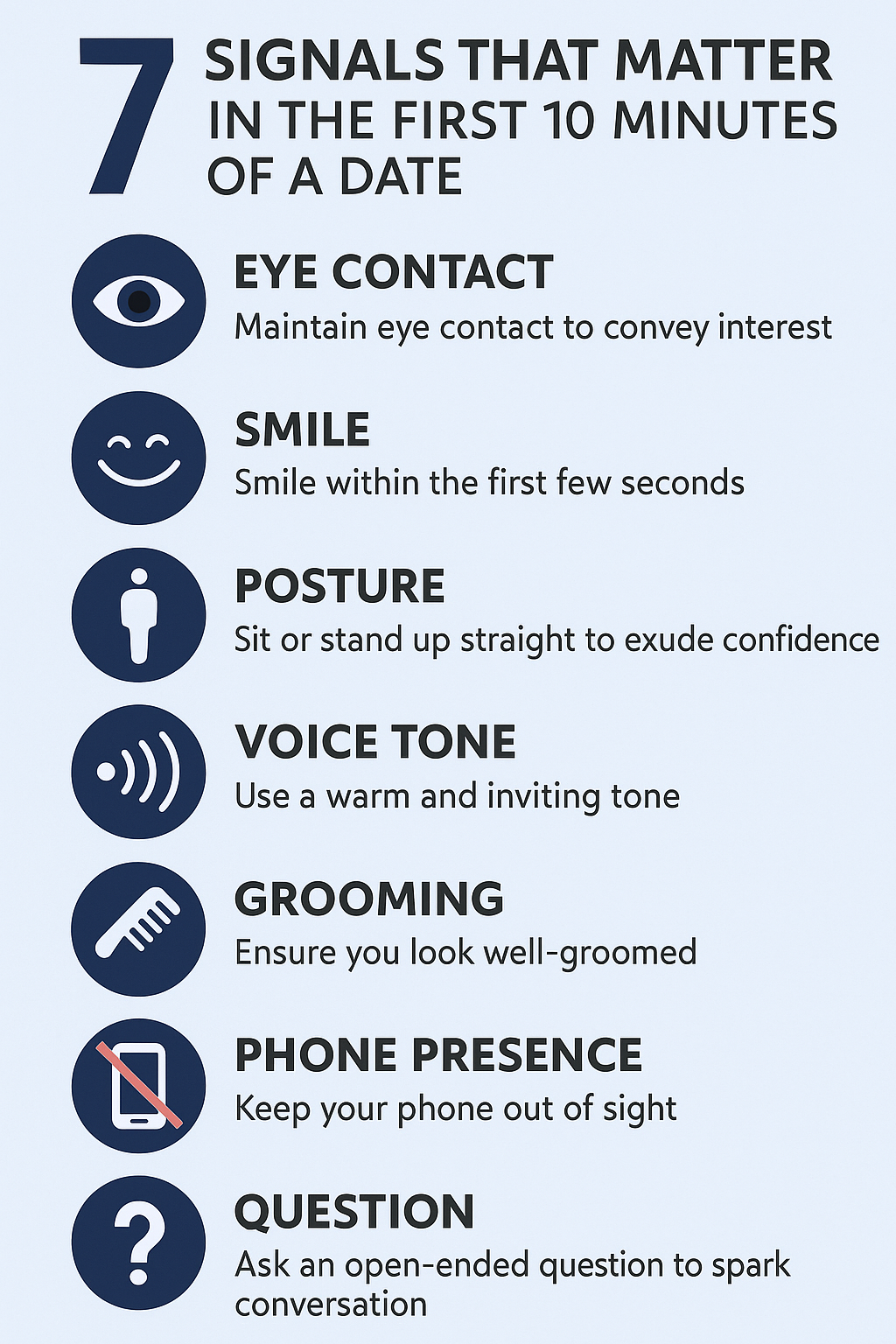First dates can be nerve-wracking, exciting, and everything in between. What many don’t realize is just how vital the first few minutes are in determining the trajectory of the relationship. Studies suggest that we form opinions about others within seconds, and these early judgments often persist. In this article, we delve into what really happens in the first 10 minutes of a first date — from body language and tone of voice to subconscious signals and psychological triggers — all backed by science and research.
The Psychology of First Impressions
Snap Judgments: Why They Happen
Human beings are hardwired to make quick decisions for survival. This evolutionary trait extends to social interactions. According to psychologist Nalini Ambady’s concept of “thin slicing,” people can make accurate assessments of others after only brief observations — sometimes in just a few seconds. On a first date, these judgments shape the level of openness, attraction, and emotional safety that follows.
Read More: Ghosted Again: Why Modern Dating Is So Emotionally Draining
The Primacy Effect
The primacy effect is a cognitive bias that suggests the information we learn first disproportionately influences our perceptions. In dating, this means the first moments of interaction — the hello, handshake or hug, eye contact, and initial tone — significantly influence how the rest of the date is interpreted.
Nonverbal Communication and Subconscious Signals
Mehrabian’s 7-38-55 Rule claims that only 7% of communication is verbal, while 38% is tone of voice, and 55% is body language. While the exact ratios are debated, research confirms that nonverbal cues like posture, facial expressions, gestures, and eye contact play a vital role in early attraction and trust-building.
What Science Says About Attraction
Physical Appearance and Grooming
While personality ultimately sustains relationships, physical appearance is a primary filter in initial attraction. A 2019 study published in “Psychological Science” found that people form lasting impressions of attractiveness within 100 milliseconds. Cleanliness, grooming, and style not only affect physical attraction but also signal self-respect and compatibility.
Voice and Speech Patterns
The tone, pitch, and speed of one’s voice can influence perceptions of warmth, confidence, and intelligence. A study by Hughes et al. (2010) revealed that women preferred men with deeper voices, associating them with strength and reliability, while men found higher-pitched female voices more attractive, linking them with youth and vitality.
The Role of Smell and Pheromones
Scent is an underrated but powerful component of attraction. Research from the University of Bern found that people can subconsciously detect immune system compatibility through body odor. While commercial perfumes can enhance appeal, natural scent plays a critical role in subconscious mate selection.

Communication Styles and Emotional Cues
Active Listening and Mirroring
Active listening — showing genuine interest by maintaining eye contact, nodding, and providing thoughtful responses — signals emotional availability. Mirroring, the subconscious imitation of another person’s behavior, enhances rapport. A study by Chartrand and Bargh (1999) showed that mirroring increases likability and smoothens social interactions.
Humor and Storytelling
Humor acts as a bonding agent, breaking tension and revealing personality. Neuroscientific studies show that shared laughter releases endorphins and strengthens social bonds. Storytelling, on the other hand, allows individuals to showcase values and experiences, fostering emotional intimacy.
Empathy and Vulnerability
Displaying empathy through facial expressions and validating statements builds trust. According to Dr. Brené Brown, vulnerability is a strength that fosters deep connection. Sharing a personal anecdote early on — without oversharing — can make the other person feel safe and seen.
Timing and Flow: The Unseen Dynamics
Synchrony and Rhythmic Coordination
Research in neuroscience and psychology shows that when people are emotionally in sync, their bodies also mirror each other’s rhythms — from blinking patterns to speech cadence. This synchrony indicates mutual interest and comfort.
Emotional Contagion
The emotions we project can be contagious. A 2014 study in “Psychological Bulletin” found that emotional states can spread through facial expressions, tone, and posture. If one person is relaxed and joyful, it can ease the other’s anxiety and elevate the overall mood.
The Role of Curiosity and Questions
Questions that go beyond surface-level topics help establish emotional intimacy. According to psychologist Arthur Aron’s famous “36 Questions” experiment, progressively intimate questions can accelerate closeness, even between strangers.
Gender Dynamics and Cultural Considerations
Gender Expectations and Social Scripts
Society often imposes different expectations on men and women in romantic contexts. While these roles are evolving, remnants of traditional dating scripts — like who initiates conversation or who pays — can influence first-date behavior and perceptions.
Cross-Cultural Differences
Cultural norms shape dating behaviors in profound ways. Eye contact might signify honesty in one culture and disrespect in another. In collectivist societies, family background may be a top concern, while individualistic cultures prioritize personal compatibility and passion.
Common First-Date Pitfalls
Oversharing or Undersharing
Revealing too much personal information too soon can be overwhelming, while being too guarded may come off as disinterest. Striking the right balance is crucial.
Smartphone Distractions
Nothing kills first-date chemistry faster than a phone on the table. A 2018 study published in the journal “Environment and Behavior” found that the mere presence of a smartphone — even if not in use — can reduce the quality of conversation and emotional connection.
Talking Too Much About Oneself
Dominating the conversation may be interpreted as narcissism or insecurity. A 50-50 balance between speaking and listening generally fosters the most positive impressions.
Enhancing the First 10 Minutes: Practical Tips
Dress for Confidence
Wear something that makes you feel comfortable and confident. Avoid experimenting with radically new styles unless you’re sure they reflect your authentic self.
Be Present, Not Perfect
Nervousness is natural, but authenticity resonates more than perfection. Focus on being curious, kind, and attentive.
Practice Mindful Breathing
Before the date, use deep-breathing exercises to calm nerves and stay grounded. This promotes a relaxed demeanor and improves focus and engagement.
Start with a Compliment or Observation
Opening with a sincere compliment or light-hearted observation (e.g., about the location or ambiance) can break the ice and establish positive energy.
Case Studies and Real-World Examples
Case Study 1: The Coffee Shop Connection
John and Lisa met for coffee. Within 5 minutes, Lisa noticed John’s attentive eye contact, relaxed posture, and sense of humor. These cues made her feel at ease, and the conversation flowed effortlessly. Both later recalled the first five minutes as the defining moment of their connection.
Case Study 2: The Awkward Silence
Anna and Mark met at a wine bar. Mark seemed distracted, frequently checking his phone. Despite his attractive appearance, Anna felt disconnected. Their date ended politely but without a spark — a direct result of Mark’s lack of presence.
Case Study 3: The Unexpected Turnaround
Rachel was nervous meeting Amir, who initially appeared reserved. However, when Rachel shared a funny travel story, Amir opened up with laughter and began sharing his own. By the 10-minute mark, their chemistry had shifted dramatically.
Conclusion: The Science of Connection
The first 10 minutes of a date are a powerful window where chemistry, communication, and compatibility are rapidly assessed. While attraction may start with physical appearance and body language, it quickly evolves based on empathy, curiosity, and emotional presence. Understanding the science behind these interactions doesn’t mean scripting or manipulating — it means showing up as your most aware and authentic self. By mastering the first 10 minutes, you lay the groundwork for genuine connection — one that might just last a lifetime.
References
- Ambady, N., & Rosenthal, R. (1992). Thin slices of expressive behavior as predictors of interpersonal consequences: A meta-analysis. Psychological Bulletin.
- Mehrabian, A. (1971). Silent Messages. Belmont, CA: Wadsworth.
- Hughes, S. M., et al. (2010). Vocal cues to attractiveness: Testing the mate quality and hormone marker hypotheses. Evolution and Human Behavior.
- Chartrand, T. L., & Bargh, J. A. (1999). The Chameleon Effect: The Perception–Behavior Link and Social Interaction. Journal of Personality and Social Psychology.
- Aron, A., et al. (1997). The Experimental Generation of Interpersonal Closeness: A Procedure and Some Preliminary Findings. Personality and Social Psychology Bulletin.
- Brown, B. (2012). Daring Greatly. Gotham Books.
- University of Bern Study on MHC and scent (2002).
- Psychological Science (2019). Visual impressions and attraction.
- Psychological Bulletin (2014). Emotional contagion in social interactions.
- Environment and Behavior (2018). The effect of mobile phone presence on face-to-face conversation quality.
Read More: India-Pakistan on the Brink: The 2025 Pahalgam Attack and the Shadow of Nuclear War







